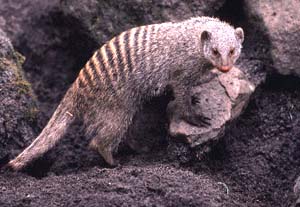
 Banded Mongoose
Banded Mongoose
scientific name
Mungos mungo
size/weight/height
Length: 12 - 16"
Tail Length: 8"
Weight: 3.5 - 5 lbs.
adaptations/coloration
Color: coat brownish-gray " feet dark brown to black " tail tip black " back dark brown bands
Claws: long " non-retractile " used for digging
Feet: 4 - 5 digits
behavior
diurnal
Bunching: response to large predator " group advances as they rub themselves on one anothers back " front ones may raise onto hind legs & make snapping lunges at enemy (effect = menacing monster relentlessly advancing with many heads)
Burrow: capable of digging but usually use termitaries, rodent holes or natural crevices which may modify
Food: dont share " each animal intensely possessive of whatever it finds, eating it ASAP
Range: may cover almost 6 miles; may travel 5+ miles per day foraging for food,
Pack: 4 - 40; live forage in pack; larger than single family unit; sexes about equal in number/status ; highly social
Scent Marking: anal glands (sometimes cheek glands) used to mark territory " often scent mark one another after slightest group separation or mild scare
Trouble: when alarmed or stressed pack bunch together with young at center & make for nearest shelter " have been seen coming to aid of individual group members
Voice: chattering from any member illicits attention of whole group
reproduction/lifespan
Lifespan: wild 10 yrs " captivity 17 yrs (record)
Sexual Maturity: female 9 - 10 mos.
Courtship: male chases female & circles her with tail held high
Mating: copulation 10 min " female may be mated by several males within group & by males of foreign group during pack clashes
Gestation: 2 mos.
Litter: 2 - 6
Birth: in den
Young: blind " helpless " very small
Parenting: newborn suckled by any lactating female in den " male plays important role in guarding young before they accompany pack " generally single animal (male or female) stays behind when pack goes foraging
Weaning: young travel with pack by ~5 weeks
Birth Interval: generally 4 times per year
diet
Carnivore
Wild: beetles, crabs, earthworms, fallen fruit, grasshoppers, ground birds & their eggs, millipedes, reptile eggs, rodents, scorpions, slugs, snails, snakes & termites
Zoo: apples, carnivore diet, high protein dog chow
habitat/range
grasslands, brushlands, woodlands, rocky country; Gambia to NE Ethiopia and south to South Africa
status
widespread " currently not in danger
oregon zoo exhibit